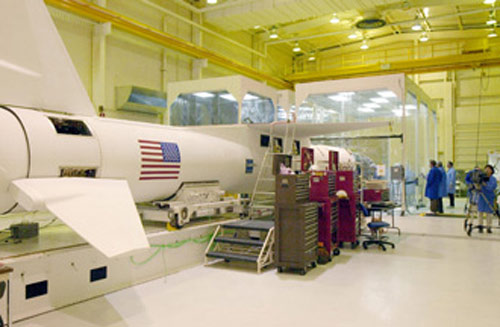Poor Weather Threatens NASA Space Technology Launch

A NASA missionto launch three small satellites on a technology-testing spaceflight Tuesday isfacing a stormy start, launch officials said Sunday.
The SpaceTechnology 5 mission, which is expected to shake down microsatellite technologiesfor future missions to track space weather, has just a 20 percent chance of rocketingspaceward from an air-based mothership due to poor weather conditions expectedfor its March 14 launch target.
Poorweather has already forced ground crews to shift their schedules during thespacecraft's weekend launch preparations, said Chuck Dovale, NASA's ST5 launchdirector, during a press conference at Vandenberg Air Force Base in California. On Sunday, hail at the mission's Vandenberg staging ground delayed batterycharging for all three microsatellites, he added.
NASA's $130million ST5 mission, part of the agency's NewMillennium Program to develop new technologies, is currently set to launchthree small microsatellites - each the size of a large cake (or 13-inchtelevision set) and weighing 55 pounds (25 kilograms) - into orbit atop anOrbital Sciences' built Pegasus XL rocket.
An L-1011Stargazer aircraft will haul the Pegasus booster to an altitude of about 39,000feet (11,887 meters) before dropping the rocket into launch position at about 9:02a.m. EST (1402 GMT). The space shot has a 77-minute launch window, Dovale said.
Technologyshakedown
Each of thethree ST5 spacecraft is expected to test six technologies that range from softwaretools for autonomous ground operations to a new cold gas micro-thruster forminute course corrections.
Breaking space news, the latest updates on rocket launches, skywatching events and more!
Themicrosatellites also carry a flux magnetometer to measure the effects of solarradiation and particles on the Earth's magnetic field, mission managers said.
Suchinteractions between particles and radiation from the Sun - such as coronalmass ejections or solar flares- and the Earth's magnetic field can interfere with satellite operations,communications- including mobile phones and pagers - and other space-based systems thatsociety has grown dependent in the last few decades.
"ST5 isgoing to measure the intensity...the stability and the motion of the electricalcurrents moving in and out of our ionosphere," said James Slavin, the mission'sproject scientist at NASA's Goddard Space Flight in Greenbelt, Maryland. "We're going to demonstrate constellation level science operations, to takemultiple spacecraft and operate them as a single instrument."
The ST5mission could lead to a future space weather monitoring system and bettertechniques to safeguard satellites from the radiation environment, Slavinadded.
"We may actuallylaunch a space weather mission with a 100 small satellites in the future,"Slavin said, adding that each of the swarm's microsatellites could bepositioned in a different location to allow better forecasts, monitoring andpossibly early-warning capabilities of solar events.
But first,the ST5 must begin its 90-day mission.
U.S AirForce Capt. David Bieger, the flight's launch weather officer for the 30thWeather Squadron at Vandenberg, said that while forecasts of rain,thunderstorms and thick clouds threatened ST5's planned Tuesday launch, therewas an 80 percent chance of favorable conditions for a March 15.
"It's muchmore favorable on Wednesday," Bieger said of ST5's launch conditions.
- Technology Test: NASA Microsats Set for Launch
- Japanese Group Sees Important Role for Microsatellites
- Powering the Future: Soup-Can Spacecraft and Postage-Stamp Engines
Join our Space Forums to keep talking space on the latest missions, night sky and more! And if you have a news tip, correction or comment, let us know at: community@space.com.

Tariq is the award-winning Editor-in-Chief of Space.com and joined the team in 2001. He covers human spaceflight, as well as skywatching and entertainment. He became Space.com's Editor-in-Chief in 2019. Before joining Space.com, Tariq was a staff reporter for The Los Angeles Times covering education and city beats in La Habra, Fullerton and Huntington Beach. He's a recipient of the 2022 Harry Kolcum Award for excellence in space reporting and the 2025 Space Pioneer Award from the National Space Society. He is an Eagle Scout and Space Camp alum with journalism degrees from the USC and NYU. You can find Tariq at Space.com and as the co-host to the This Week In Space podcast on the TWiT network. To see his latest project, you can follow Tariq on Twitter @tariqjmalik.
